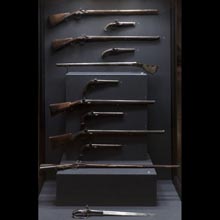
1. Flint-lock gun
Poland, Częstochowa, gunsmith Rochus Daiczer, about 1760
Eastern barrel, unrifled, calibre: 22 mm
2. Flint-lock pistol
Poland, Częstochowa, gunsmith Rochus Daiczer, 2nd half of the 18th century
Unrifled, calibre: 16,6 mm
3. Percussion gun
Poland, Częstochowa, gunsmith Rochus Daiczer, 18th century
Eastern barrel, original flint lock replaced in the 19th century with percussion lock
Unrifled, calibre: 15 mm
4. Flint-lock pistol
Holland, Mastrecht, signed „Corbou le Jeune”, about 1770
Unrifled, calibre: 15 mm
5. Flint-lock rifle
Baltic countries, signed „Martin Schertiger a Refal”, 1697
Rifled, calibre: 9 mm
From the former collection of the Moszyński family
6. Percussion pistol
Poland, Lvov, gunsmith T. Wiśniowiecki, about 1850
Rifled, calibre: 12 mm
7. Flint-lock gun
Poland, gunsmith Matheus Zieliński, mid-18th century
Unrifled, calibre: 18 mm
8. Pair of flint-lock pistols
France, about 1730, and Tulczyn, Ukraine, about 1810 r., barrel signed „Thiemay”, lock signed „Szomański w Tulczynie”
Unrifled, calibre: 14 mm
From the former collection of the Moszyński family
9. Flint-lock hunting gun
Poland, Lvov, signed „Uszyński”, eastern barrel from the 18th century, lock and stock from 1830
Unrifled, calibre: 15 mm
10. Flint-lock rifle
Poland, Warsaw, gunsmith C. L. Giebenhan, early 19th century
Turkish barrel, rifled, calibre: 13 mm
11. Sword-palash combined with flint-lock pistol
Western Europe, early 18th century
Unrifled, calibre: 13,8 mm
exposition: Gallery „Arms and Uniforms in Poland",
The Main Building, 1, 3 Maja Av.
key: Firearms <<<
The collection of handheld firearms and shooting equipment, with articles dating from the 16th to the 19th centuries, is one of the finest in Poland. The most stunning and valuable items come from well-known collectors: Emeryk Hutten-Czapski, Piotr Moszyński and Erazm Barącz. Using preserved examples as a guide, it is possible to trace the development and use of firearms from 16th-century muskets and arquebuses with matchlocks and wheellocks through 17th- and 18th-century flintlock weapons to 19th century muzzle-loading percussion rifles and the earliest breech-loading military firearms. Some of the earliest examples in the collection include a fowling piece from 1560, produced on commission for Julius of Brunswick-Wolfenbüttel for the occasion of his wedding to the Brandenburg Duchess Hedwiga on the 25th of February 1560, and a seven-barrelled wheellock pistol produced between 1560 and 1596 in Nuremberg. The collection is home to objects from the largest and most famed gunmanufactures in Europe. From Germany come weapons produced in the 16th and 17th centuries in Munich, Nuremberg (including a fowling piece with a double wheel- match-lock, dated to 1595), Wolfenbüttel, Augsburg, Dresden, and Suhl and from the 18th and 19th century in Regensburg. From France there are products of the famous 19th century gunsmith Nicolas Boutet, who worked from Versailles, and jean LaPage, who had his workshop in Paris. Arms from other, less significant gunsmithing cetres are represented in the collection by pisotls and fowling pieces produced in Tula, Prague, Vienna, Liége, Madrid, and Spanish Rippol and Scottish Dandee.
The inclusion of handheld firearms produced in Poland, while less numerous in the collection, gives an opportunity to learn about the development of the nation’s gusmithing trade. One of the most valuable objects is a grenade musket with a (bronze) barrel from 1594 and a set of 17th-century Cieszyn fowling pieces decorated with intricate inlaid with mother of pearl and ivory. The collection also contains arms by well-known gunsmiths, such as 18th-century pieces from the Częstochowa workshop of Rochus Daiczer. Polish gunsmithing of the first half of the nineteenth century, strongly influenced by the French style, is represented by a pistol signed by Mr. Szomański from Tulczyn in Podole, also the manufacturer of the crossbow pistol. From Warsaw’s gunsmithies come fowling pieces by Egidiusz Collete and Karol Ludwik Gibenhann, and from Krakow area pistols and a fowling barrel made by Ignacy Höfelmajer in the 1960s.There are also many weapons that have been owned by known historical figures. Worthy of note among them are a few pistols from the Royal Factory in Naples from about 1770, presented by Prince Józef Poniatowski to General Klemens Kołaczkowski, and a few English pistols, said to have been given by George Washington to Tadeusz Kościuszko.
The collection of shooting equipment includes noblemen’s and military ammunition pouches, which served to store ammunition, as well as powder horns from the Saxon times, the period of Stanisław August Poniatowski’s reign, and from the 19th century.
Piotr Wilkosz












